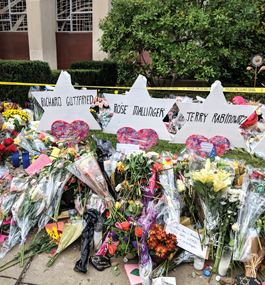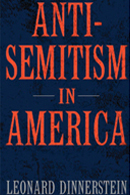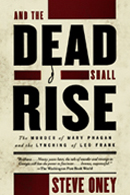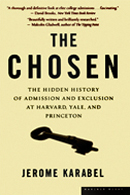‘When the Wolves of Hate Are Loosed’
Recommended reading for understanding the latest resurgence of antisemitism in America.

Dmitry Brant / Wikimedia Commons
Memorials for the victims of the Tree of Life synagogue shooting in Pittsburgh.
According to the Anti-Defamation League’s most recent report, antisemitic incidents in the United States skyrocketed almost 60 percent in 2017, the largest single-year increase on record. Much of the rise was due to incidents that took place in schools or on college campuses.
Some experts believe the upsurge indicates the number of American antisemites is growing. Others say that new technologies, divisive politics and an overall decline in civility have emboldened antisemites to redouble their activities. Whatever the cause, extremists on both the right and the left are increasingly targeting Jews, and politicians in both major U.S. political parties have been called out for engaging in antisemitic rhetoric.
To help make sense of this scourge, University Professor Jonathan D. Sarna ’75, MA’75, the Joseph H. and Belle R. Braun Professor of American Jewish History, and author of the award-winning historical account “When General Grant Expelled the Jews” (Schocken, 2012), here recommends five books that shine a light on the roots of antisemitism in the U.S.
 |
Antisemitism in America “Exactly one comprehensive scholarly history of American antisemitism exists; this is it. “Leonard Dinnerstein chronicles all aspects of antisemitism in American history from the Colonial period to the 1990s. He situates antisemitism within the context of Christian hostility toward Jews and compares the hatred of Jews with other forms of American animus.” |
 |
And the Dead Shall Rise: The Murder of Mary Phagan and the Lynching of Leo Frank “Until October’s mass shooting in the Pittsburgh synagogue, the most notorious antisemitic incident in American history was the 1915 lynching of Leo Frank outside Atlanta. “Two years earlier, Frank had been charged with the murder of 13-year-old Mary Phagan. His trial took place in an atmosphere poisoned by virulent antisemitism. Although a terrorized jury found Frank guilty, the judge and later the Georgia governor thought the evidence unconvincing, and the sentence was commuted. Outraged citizens, stirred up by demagogic newspaper editor Thomas E. Watson, broke into the jail where Frank was being held, seized him and lynched him. Only later was the true murderer identified. “Journalist Steve Oney spent years investigating this tragedy, and his book — written like an epic novel — peels away its layers to provide the definitive story, replete with ironies, paradoxes and horrors.” |
 |
Henry Ford and the Jews: The Mass Production of Hate “For 91 successive weeks, beginning on May 22, 1920, The Dearborn Independent, a newspaper published by automaker Henry Ford, purported to describe an international Jewish conspiracy based on the notorious antisemitic forgery known as ‘The Protocols of the Elders of Zion.’ “‘The International Jew,’ a four-volume set of booklets drawn from the newspaper’s stories, reprinted these scurrilous charges, which included such fantastic claims as ‘Rule of the Jewish Kehillah Grips New York’ and ‘Jewish Jazz Becomes Our National Music.’ Hundreds of thousands of the booklets were distributed. “Only in 1927, under intense economic and legal pressure, did Ford publicly recant and apologize. By then, the damage had been done. “Neil Baldwin offers the authoritative account of Ford’s antisemitism, from its origins in his childhood, to its repercussions in the 1930s, to the implications that extend to today.” |
 |
The Chosen: The Hidden History of Admission and Exclusion at Harvard, Yale and Princeton “Well into the 20th century, Ivy League universities restricted the number of Jews they enrolled by using a strict quota system. “Although social discrimination against Jews was common then, until sociologist Jerome Karabel gained access to archive materials the full story of how America’s top universities discriminated against Jews (as well as blacks, women and other minority groups) had never been fully told. “Among other things, the book makes clear why, 70 years ago, Brandeis founders insisted on following a different path and based their new university’s admissions upon merit.” |
 |
The Temple Bombing “In the early-morning hours of Oct. 12, 1958 — exactly 60 years to the month before the massacre of 11 Jews in Pittsburgh’s Tree of Life synagogue — a nitroglycerine bomb equal to 50 sticks of dynamite tore apart the Temple, the oldest and most distinguished Reform congregation in Atlanta. “Melissa Fay Greene’s book recounts in meticulous detail the story of this bombing, contextualizing it within the civil rights struggle and the tumultuous transformation of the South in the wake of court-ordered desegregation. One chapter quotes the courageous Ralph McGill, editor of The Atlanta Constitution, who wrote in an editorial published in the bombing’s wake, ‘When the wolves of hate are loosed on one people, then no one is safe.’” |
